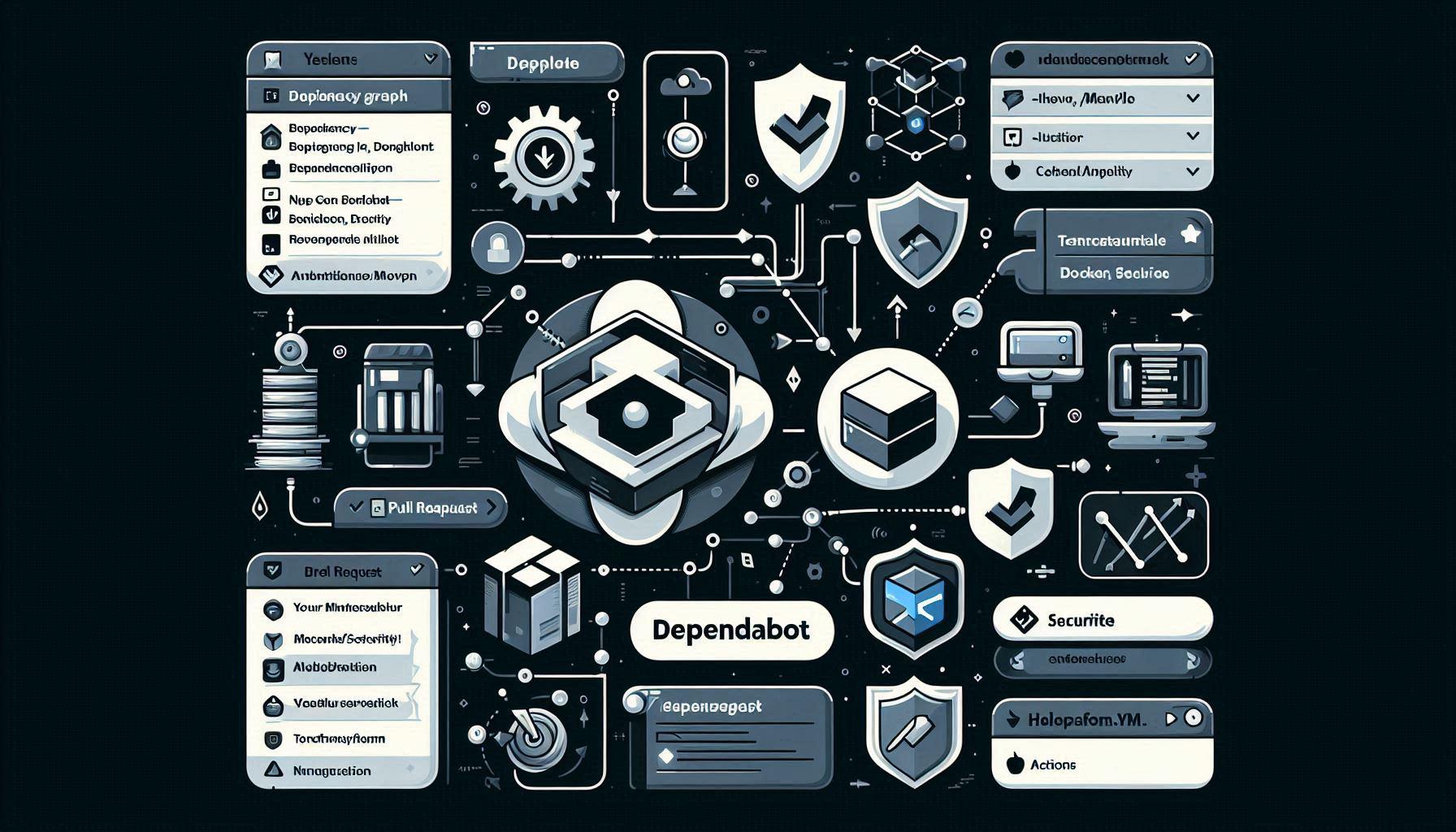Getting started with Dependabot

Dependabot is the easiest way to keep dependencies current and secure in your GitHub repositories. It can: alert on vulnerabilities, open PRs to fix them, and keep versions fresh with scheduled updates. This guide shows how to enable Dependabot, add a robust dependabot.yml, and include small optimisations for specific ecosystems.
What you’ll set up
- Enable Dependabot alerts, security updates, and version updates.
- Create and tune a
.github/dependabot.ymlthat covers your package managers. - Add optional Java metadata to improve PR quality.
Enable Dependabot in your repository
Use the repository UI:
- Go to Settings.
- Under Security, open Advanced Security.
- Enable: Dependabot alerts, Dependabot security updates, and Dependabot version updates.
If you enable version updates from the UI, GitHub adds a default .github/dependabot.yml you can edit.
Create dependabot.yml
Dependabot looks for a .github/dependabot.yml at the repo root. Here’s a practical starting file that covers common ecosystems. Adjust directories and schedules to match your repo layout.
version: 2
updates:
# JavaScript/TypeScript (npm or pnpm)
- package-ecosystem: "npm"
directory: "/"
schedule:
interval: "weekly" # daily | weekly | monthly
open-pull-requests-limit: 10
labels: ["dependencies"]
# GitHub Actions (workflow uses action@version syntax only)
- package-ecosystem: "github-actions"
directory: "/"
schedule:
interval: "weekly"
# Docker (Dockerfiles and image tags in k8s manifests/Helm charts)
- package-ecosystem: "docker"
directory: "/"
schedule:
interval: "weekly"
# Maven (Java)
- package-ecosystem: "maven"
directory: "/"
schedule:
interval: "weekly"
# Gradle (Java/Kotlin)
- package-ecosystem: "gradle"
directory: "/"
schedule:
interval: "weekly"
# Terraform
- package-ecosystem: "terraform"
directory: "/"
schedule:
interval: "weekly"
info
- For pnpm and some others, you still use
package-ecosystem: "npm"(see Supported ecosystems). - Poetry and pipenv use the
pipYAML value (see Supported ecosystems). - If you have multiple package roots (for example, monorepos), add one
updatesentry per directory.
Useful options to consider
ignore: ignore specific dependencies or version ranges.allow: restrict updates to a list of dependencies.commit-message: add a prefix such asdeps:.target-branch: direct PRs to a non-default branch.rebase-strategy: control how rebases are handled.
See the Dependabot options reference for the full list.
Ecosystem specifics and caveats
GitHub Actions
- Dependabot only updates actions referenced with the GitHub repository syntax:
owner/repo@vX(for example,actions/checkout@v5). - Local action references like
./.github/actions/fooand container actions viadocker://are ignored.
Docker and Kubernetes/Helm
- Dependabot can add metadata (release notes/changelogs) to Docker PRs when images include the
org.opencontainers.image.sourcelabel in their Dockerfile and matching tags. - It can update image tags inside Kubernetes manifests and Helm charts when you configure a
dockerentry for those directories.
Java (Maven and Gradle)
Dependabot uses dependency metadata to enrich PRs. For libraries you publish, add these to your pom.xml so Dependabot can link to release notes and issues.
<project>
<url>https://github.com/OWNER/REPOSITORY</url>
<scm>
<url>https://github.com/OWNER/REPOSITORY</url>
</scm>
<issueManagement>
<url>https://github.com/OWNER/REPOSITORY/issues</url>
</issueManagement>
</project>
- Gradle: Dependabot updates
build.gradle,build.gradle.kts, and standard version catalogs (gradle/libs.versions.toml). - Maven: Dependabot updates
pom.xmlfiles.
If metadata is missing, PRs are still created, but without rich links.
Terraform
- Dependabot updates providers and modules (including OCI/registry sources). Private registries are supported with proper configuration.
Dev containers
- Use
package-ecosystem: "devcontainers"to keep Features up to date indevcontainer.jsonand lockfiles.
Private registries and private dependencies
Dependabot can access private package registries and private GitHub repositories, but you must configure credentials in dependabot.yml and/or grant org access. See “Configuring access to private registries for Dependabot” and “Managing security and analysis settings for your organisation” in the official docs.
Tip: Keep credentials in GitHub secrets and reference them from dependabot.yml rather than using plaintext.
How Dependabot runs
- Alerts: appear on the repository Security tab when the dependency graph detects known vulnerabilities.
- Security updates: PRs that bump vulnerable versions to a patched release.
- Version updates: PRs on a schedule to keep you current.
After you commit dependabot.yml, Dependabot will scan and begin creating PRs based on your schedule. You can merge, close, or tweak the config and rerun.
Troubleshooting essentials
- Dependabot must be able to resolve all dependencies. If manifests reference private sources, provide access.
- For Actions, only
owner/repo@versionreferences are updatable. - For Docker metadata in PRs, ensure images include the
org.opencontainers.image.sourcelabel and matching tags. - Some ecosystems (for example, Gradle security updates) may rely on dependency submission; check the ecosystem notes in Supported ecosystems.
Advanced configuration and operations
- Managing PRs for dependency updates: https://docs.github.com/en/code-security/dependabot/working-with-dependabot/managing-pull-requests-for-dependency-updates
- Automating Dependabot with GitHub Actions: https://docs.github.com/en/code-security/dependabot/working-with-dependabot/automating-dependabot-with-github-actions
- Keeping your actions up to date with Dependabot: https://docs.github.com/en/code-security/dependabot/working-with-dependabot/keeping-your-actions-up-to-date-with-dependabot
- Configuring access to private registries: https://docs.github.com/en/code-security/dependabot/working-with-dependabot/configuring-access-to-private-registries-for-dependabot
- Guidance for private registry configuration: https://docs.github.com/en/code-security/dependabot/working-with-dependabot/guidance-for-the-configuration-of-private-registries-for-dependabot
- Configuring multi-ecosystem updates: https://docs.github.com/en/code-security/dependabot/working-with-dependabot/configuring-multi-ecosystem-updates
- About Dependabot on GitHub Actions runners: https://docs.github.com/en/code-security/dependabot/working-with-dependabot/about-dependabot-on-github-actions-runners
- Running on self-hosted runners with ARC: https://docs.github.com/en/code-security/dependabot/working-with-dependabot/setting-dependabot-to-run-on-self-hosted-runners-using-arc
- Running on GitHub-hosted runners with Azure VNET: https://docs.github.com/en/code-security/dependabot/working-with-dependabot/setting-dependabot-to-run-on-github-hosted-runners-using-vnet
Recap
- Enable alerts, security updates, and version updates.
- Add a single
.github/dependabot.ymland include oneupdatesentry per ecosystem and directory. - For Java, add project metadata in
pom.xmlto improve PRs. - Review supported ecosystems for caveats, private registries, and special cases.
Happy patching and stay secure.